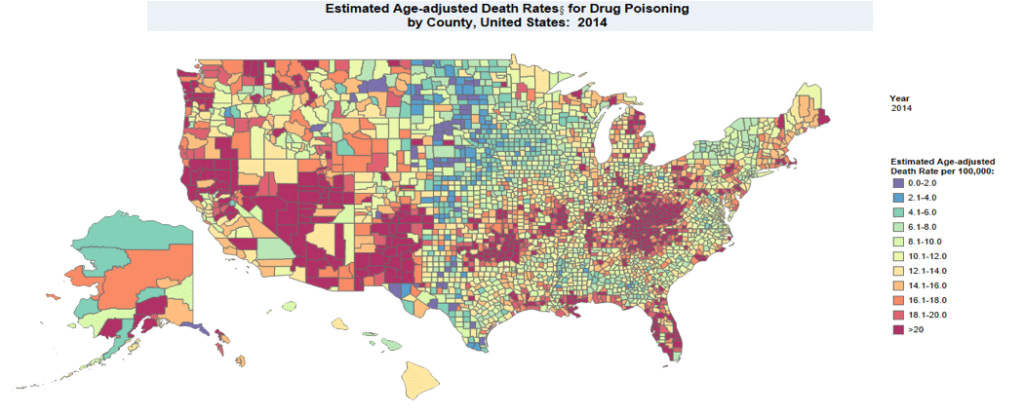If you have any doubt that addiction is spreading like a plague across the nation, check out the statistical storyboard created by the Centers for Disease Control and Prevention and shared below. It’s a sobering assortment of interactive bar graphs, charts and maps that tracks the changes in drug overdose deaths from 2002 to 2014 from a variety of perspectives, including age, sex, race and region. And the numbers aren’t good. Overall drug overdoses have more than doubled in the 12-year time frame, from 23,518 to 47,055. That’s due in large part to skyrocketing addictions to opioids such as prescription painkillers and heroin. And those death rates have been boosted lately by the increased use of the powerful synthetic opioid fentanyl, which is sometimes used to cut heroin or sold to unsuspecting users as heroin. Perhaps the most eye-opening visual within the CDC storyboard is a map of the U.S. showing a county-by-county breakdown of the overdose deaths. In 2002, the map is mostly purples and greens, indicating the lowest rates of drug poisoning deaths. The reds, which indicate the highest overdose levels (more than 20 deaths per 100,000 population), are a few small dots here and there. With each year, however, the red increases, until by 2014, large red blotches dominate the map, particularly in the Southwest and Appalachia. Among the other findings:
- Overdose deaths among blacks and Hispanics increased slightly from 2002 to 2014, while death rates among whites more than doubled.
- In a state-by-state analysis, New Mexico alone had overdose death rates of more than 15.4 per 100,000 population in 2002. By 2014, it was joined by much of the nation, including the entire Southwest, large swathes of Appalachia and the Northeast, and states including Alaska, Louisiana and Oklahoma.
- In 2002, most drug overdoses occurred in those ages 35 to 44. In 2014, the 45-to-54 age group was hardest hit.
While the statistics compiled within the storyboard offer little that is encouraging, the findings do at least add to the wealth of evidence that is prompting increased government spending on solutions and fueling calls for change in the way we respond to those with addictions. “More Americans now die every year from drug overdoses than they do from motor vehicle crashes,” President Obama noted in a 2015 speech. “The majority of those overdoses involve legal prescription drugs. I don’t have to tell you, this is a terrible toll.”
By Kendal Patterson Follow Kendal @kendalpatterson

